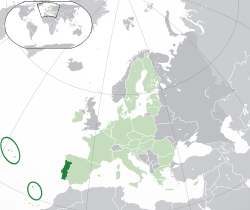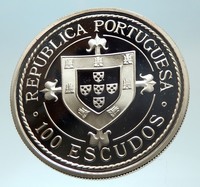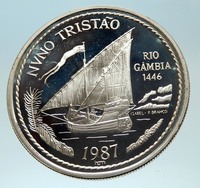Portugal - Golden Age of Portuguese Discoveries - Nuno Tristão
1987 Proof Silver 100 Escudos 33mm (16.47 grams) 0.925 Silver (0.4907 oz. ASW)
Reference: KM# 640a
REPUBLICA PORTUGUESA 100 ESCUDOS, Shield flanked by crowns within circle.
NVNO TRISTÃO RIO GAMBIA 1446 ISABEL · F BRANCO 1987 incm, A caravel with lateen sails, the boat used by Nuno Tristao during his navigations down the coast of Africa (ordered by Henri the Navigator). He reached the Rio Gambia in 1446, during his last voyage. Date of the coin below.
You are bidding on the exact item pictured, provided with a Certificate of Authenticity and Lifetime Guarantee of Authenticity.
Nuno Tristão was a 15th-century Portuguese explorer and slave trader, active in the early 1440s, traditionally thought to be the first European to reach the region of Guinea (legendarily, as far as Guinea-Bissau, but more recent historians believe he did not go beyond the Gambia River). First voyage Nuno Tristão was a knight of the household of Henry the Navigator. In 1441, Tristão was dispatched by Henry in one of the first prototypes of the lateen-rigged caravel to explore the West African coast beyond Cape Barbas, the furthest point reached by Henry's last captain five years earlier (Afonso Gonçalves Baldaia, in 1436). Around Rio de Oro, Tristão met up with the ship of Antão Gonçalves, who had been sent on a separate mission by Henry that same year to hunt monk seals that basked on those shores. But Gonçalves happened to capture a solitary young camel-driver, the first native encountered by the Portuguese since the expeditions began in the 1420s. Nuno Tristão, who carried on board one of Henry's Moorish servants to act as an interpreter, interrogated Gonçalves's captive camel-driver. Tristão and Gonçalves were led by his information to a small Sanhaja Berber fishing camp nearby. The Portuguese attacked the fishermen, taking some ten captives, the first African slaves taken by the Portuguese back to Europe. Gonçalves returned to Portugal immediately after the slave raid, but Nuno Tristão continued south, reaching as far as Cape Blanc (Cabo Branco), before turning back. Second voyage In 1443, Nuno Tristão was sent out by Henry again, and pressed beyond Cape Blanc to reach the Bay of Arguin. On Arguin island, Tristão encountered a Sanhaja Berber village, the first permanent settlement seen by Henry's captains on the West African coast. Tristão immediately attacked it, taking some fourteen villagers captive and returned to Portugal with his captives. Tristão's report of easy and profitable slave-raiding grounds in the Arguin banks prompted numerous Portuguese merchants and adventurers to apply to Henry for a slave-trading license. Between 1444 and 1446 several dozen Portuguese ships set out for slave raids around Arguin Bay. Third voyage As fishing settlements around the Arguin banks were quickly devastated by the Portuguese slave raiders, in 1445 (or possibly 1444), Nuno Tristão was sent by Henry to press further south and look for new slave-raiding grounds. Tristão reached as far south as borderlands of Senegal, where the Sahara desert ends and forest begins, and the coastal population changed from 'tawny' Sanhaja Berbers to 'black' Wolofs. Tristão is believed to have reached as far as the Ponta da Berberia (Langue de Barbarie), just short of the entrance to the Senegal River. Bad weather prevented his entering the river or landing there, so he set sail back. On the way home, Tristão stopped by the Arguin banks and took another 21 Berbers captive. Nuno Tristão arrived in Portugal declaring he had finally discovered sub-Saharan Africa, or in the nomenclature of the time, the "Land of the Blacks" (Terra dos Guineus, or simply Guinea). Portuguese slave raiders immediately descended on the Senegalese coast, but finding alert and better-armed natives on that coast, the slave raids were not nearly as easy nor as profitable as they had hoped. Fourth voyage In 1446 (or perhaps 1445 or 1447, date uncertain), Nuno Tristão set out on his fourth (and final) trip down the West African coast. Somewhere south of Cap Vert, Tristão came across the mouth of a large river. Tristão took 22 sailors with him on a launch upriver, to search for a settlement to raid. But the launch was ambushed by thirteen native canoes with some 80 armed men. Quickly surrounded, Nuno Tristão, along with most of his crew, was killed on the spot by poisoned arrows (two might have escaped). Tristão's caravel, reduced to a crew composed of clerk Aires Tinoco and four grumetes ('ship boys'), immediately set sail back to Portugal. (However, the account of Diogo Gomes differs here; he asserts the caravel never made it back-that the native canoes overpowered and seized it, and then dragged the caravel and dismantled it upriver.) It is uncertain how far Nuno Tristão actually sailed and where he died. Up until the 1940s, Portuguese tradition asserted Tristão died at Rio do Nuno (Nunez River, modern Guinea), or that he fell just short of it, and died at Rio Grande (Geba River, Guinea-Bissau). As a result, Nuno Tristão was traditionally credited as the 'discoverer' of Portuguese Guinea (modern Guinea-Bissau), and even said to have been the first European to set foot on the landmass of what is now the modern city of Bissau. If true, then Nuno Tristão's last journey was an enormous leap beyond the previous Portuguese milestone (Cabo dos Mastos, Cape Naze, Senegal). However, modern historians, drawing from larger evidence (including the accounts of Diogo Gomes and Cadamosto), have generally dismissed this claim and now generally agree that Nuno Tristão only reached as far as the Sine-Saloum delta, still in Senegal, just a few miles south of Cape of Masts (Cape Naze) or, at their most generous, the Gambia River. Exactly where has been subject to debate. In his careful investigation, historian Teixeira da Mota concluded that Nuno Tristão first prodded up the Saloum River (Rio de Barbacins, 13°57′47″N 16°45′10″W) then sent his launch up the Diombos River (Rio de Lago, 13°47′57″N 16°36′19″W), the south bank of which was controlled by the Mandinka king known as Niumimansa, of the Niumi Bato. It was these Mandinka (or Mandikized) warriors that ambushed and killed Nuno Tristão. Other scholars attribute the killing of the Portuguese slave raider and his party to the Serer people of Senegambia. This is the general consensus. The death of Nuno Tristão, Henry's favorite captain, was the beginning of the end of this wave of Henry's expeditions. Another set of ships would be still go out the next year, but would also take significant casualties, and as a result, Portuguese expeditions were temporarily suspended. Henry the Navigator did not dispatch another expedition to the West African coast again until a decade later (Cadamosto in 1455).
  Portugal, officially the Portuguese Republic (Portuguese: República Portuguesa), is a country on the Iberian Peninsula, in Southwestern Europe. It is the westernmost country of mainland Europe, being bordered by the Atlantic Ocean to the west and south and by Spain to the north and east. The Portugal-Spain border is 1,214 km (754 mi) long and considered the longest uninterrupted border within the European Union. The republic also includes the Atlantic archipelagos of the Azores and Madeira, both autonomous regions with their own regional governments. Portugal, officially the Portuguese Republic (Portuguese: República Portuguesa), is a country on the Iberian Peninsula, in Southwestern Europe. It is the westernmost country of mainland Europe, being bordered by the Atlantic Ocean to the west and south and by Spain to the north and east. The Portugal-Spain border is 1,214 km (754 mi) long and considered the longest uninterrupted border within the European Union. The republic also includes the Atlantic archipelagos of the Azores and Madeira, both autonomous regions with their own regional governments.
 The territory of modern Portugal has been continuously settled, invaded and fought over since prehistoric times. The Pre-Celts, Celts, Phoenicians, Carthaginians and the Romans were followed by the invasions of the Visigothic and the Suebi Germanic peoples, who were themselves later invaded by the Moors. These Muslim peoples were eventually expelled during the Christian Reconquista. Portuguese nationality can be traced back to the creation of the First County of Portugal, in 868. In 1139, Afonso Henriques was proclaimed King of Portugal, thus firmly establishing Portuguese independence, under the Portuguese House of Burgundy. The territory of modern Portugal has been continuously settled, invaded and fought over since prehistoric times. The Pre-Celts, Celts, Phoenicians, Carthaginians and the Romans were followed by the invasions of the Visigothic and the Suebi Germanic peoples, who were themselves later invaded by the Moors. These Muslim peoples were eventually expelled during the Christian Reconquista. Portuguese nationality can be traced back to the creation of the First County of Portugal, in 868. In 1139, Afonso Henriques was proclaimed King of Portugal, thus firmly establishing Portuguese independence, under the Portuguese House of Burgundy.
In the 15th and 16th centuries, under the House of Aviz, which took power following the 1383-85 Crisis, Portugal expanded Western influence and established the first global empire, becoming one of the world's major economic, political and military powers. During this time, Portuguese explorers pioneered maritime exploration in the Age of Discovery, notably under royal patronage of Prince Henry the Navigator and King João II, with such notable discoveries as Vasco da Gama's sea route to India (1497-98), Pedro Álvares Cabral's discovery of Brazil (1500), and Bartolomeu Dias's reaching of the Cape of Good Hope. Portugal monopolized the spice trade during this time, under royal command of the Casa da Índia, and the Portuguese Empire expanded with military campaigns led in Asia, notably under Afonso de Albuquerque, who was known as the "Caesar of the East". The destruction of Lisbon in a 1755 earthquake, the country's occupation during the Napoleonic Wars, the independence of Brazil (1822), and the Liberal Wars (1828-1834), all left Portugal crippled from war and diminished in its world power. After the 1910 revolution deposed the monarchy, the democratic but unstable Portuguese First Republic was established, later being superseded by the "Estado Novo" right-wing authoritarian regime. Democracy was restored after the Portuguese Colonial War and the Carnation Revolution in 1974. Shortly after, independence was granted to all its colonies and East Timor, with the exception of Macau, which was handed over to China in 1999. This marked the end of the longest-lived European colonial empire, leaving a profound cultural and architectural influence across the globe and a legacy of over 250 million Portuguese speakers today. Portugal is a developed country with a high-income advanced economy and high living standards. It is the 5th most peaceful country in the world, maintaining a unitary semi-presidential republican form of government. It has the 18th highest Social Progress in the world, putting it ahead of other Western European countries like France, Spain and Italy. It is a member of numerous international organizations, including the United Nations, the European Union, the eurozone, OECD, NATO and the Community of Portuguese Language Countries. Portugal is also known for having decriminalized the usage of all common drugs in 2001, the first country in the world to do so. However, the sale and distribution of these drugs is still illegal in Portugal.
|



 Portugal, officially the Portuguese Republic (Portuguese: República Portuguesa), is a country on the Iberian Peninsula, in Southwestern Europe. It is the westernmost country of mainland Europe, being bordered by the Atlantic Ocean to the west and south and by Spain to the north and east. The Portugal-Spain border is 1,214 km (754 mi) long and considered the longest uninterrupted border within the European Union. The republic also includes the Atlantic archipelagos of the Azores and Madeira, both autonomous regions with their own regional governments.
Portugal, officially the Portuguese Republic (Portuguese: República Portuguesa), is a country on the Iberian Peninsula, in Southwestern Europe. It is the westernmost country of mainland Europe, being bordered by the Atlantic Ocean to the west and south and by Spain to the north and east. The Portugal-Spain border is 1,214 km (754 mi) long and considered the longest uninterrupted border within the European Union. The republic also includes the Atlantic archipelagos of the Azores and Madeira, both autonomous regions with their own regional governments. The territory of modern Portugal has been continuously settled, invaded and fought over since prehistoric times. The Pre-Celts, Celts, Phoenicians, Carthaginians and the Romans were followed by the invasions of the Visigothic and the Suebi Germanic peoples, who were themselves later invaded by the Moors. These Muslim peoples were eventually expelled during the Christian Reconquista. Portuguese nationality can be traced back to the creation of the First County of Portugal, in 868. In 1139, Afonso Henriques was proclaimed King of Portugal, thus firmly establishing Portuguese independence, under the Portuguese House of Burgundy.
The territory of modern Portugal has been continuously settled, invaded and fought over since prehistoric times. The Pre-Celts, Celts, Phoenicians, Carthaginians and the Romans were followed by the invasions of the Visigothic and the Suebi Germanic peoples, who were themselves later invaded by the Moors. These Muslim peoples were eventually expelled during the Christian Reconquista. Portuguese nationality can be traced back to the creation of the First County of Portugal, in 868. In 1139, Afonso Henriques was proclaimed King of Portugal, thus firmly establishing Portuguese independence, under the Portuguese House of Burgundy.
